Physical Address
304 North Cardinal St.
Dorchester Center, MA 02124
The contributions of Dr. Anthony Chang, Department of Pathology, University of Chicago, and Dr. Zoltan Laszik, Department of Pathology, University of California San Francisco, to previous editions of this chapter are gratefully acknowledged.
The well-known quotation “What is man…but an ingenious machine for turning, with infinite artfulness, the wine of Shiraz into urine” gives rather dramatic importance to the renal apparatus. In reality, the kidney is responsible for the following:
Excretion of soluble wastes , which are filtered out of the plasma; this is the primary function of glomeruli.
Maintenance of ion balance. Renal tubules absorb water and salts and thus regulate their concentration in the plasma.
Regulation of blood pressure. The juxtaglomerular apparatus produces the hormone renin in response to reduced arterial flow or pressure. Renin in turn activates angiotensin, which constricts peripheral blood vessels and indirectly increases renal tubular reabsorption of sodium and water, which increases fluid volume; both these alterations serve to maintain normal blood pressure.
Hormone secretion. The kidney produces erythropoietin, which regulates the hematocrit. The enzyme α 1 hydroxylase, also produced in the kidney, is responsible for producing the active form of vitamin D.
These functions depend on the coordinated actions of the four main structural components of the kidney:
Glomeruli are the filtration units of the kidney. Their structure is described later, when we consider glomerular diseases.
Tubules reabsorb water, small molecules, and ions that have been filtered through the glomeruli.
The interstitium provides the scaffold that supports glomeruli and tubules.
Blood vessels deliver arterial blood to glomeruli and return venous blood to the circulation.
These components function in a coordinated manner, so pathologic alterations in one usually affect the other structures. Nevertheless, we discuss them separately, mainly because diseases initially affecting different components usually differ in their pathogenesis. For example, most glomerular diseases are immunologically mediated, whereas tubular and interstitial disorders are more often caused by toxic or infectious agents. Because these disorders are typically associated with inflammation, they are called glomerulonephritis (GN) and tubulointerstitial nephritis (TIN), respectively. When chronic kidney disease progresses to its most advanced stage, so-called end-stage renal disease, all four compartments of the kidney are usually damaged.
The clinical manifestations of renal disease reflect the underlying pathophysiology ( Table 12.1 ). Before discussing individual diseases, we summarize the principal clinical features of renal disorders.
Nephrotic syndrome is caused by glomerular alterations that result in increased glomerular permeability. It is characterized by the following:
Proteinuria , with daily protein loss in the urine of 3.5 g or more in adults (said to be in the “nephrotic range”), due to leakage of plasma proteins through an abnormally permeable glomerular basement membrane
Hypoalbuminemia, with plasma albumin levels dropping below 3 g/dL because of urinary loss of proteins, particularly albumin because it has a lower molecular weight than globulins
Generalized edema, because of decreased plasma colloid osmotic pressure due to the hypoalbuminemia, leading to leakage of fluid from the blood into extravascular spaces
Hyperlipidemia and lipiduria . The cause of the hyperlipidemia is unclear but is thought to be due to a combination of increased hepatic lipoprotein synthesis, abnormal transport of circulating lipid particles, and decreased lipid catabolism. The associated lipiduria reflects the increased permeability of the glomerular basement membrane (GBM) to lipoproteins.
Nephritic syndrome is caused by glomerular inflammation and is characterized by the following:
Hematuria (red cells and red cell casts in urine) and white blood cells in the urine due to leakage through injured glomerular capillary walls
Proteinuria (usually in the subnephrotic range) with or without edema
Azotemia (defined below) resulting from reduced glomerular filtration rate (GFR)
Hypertension caused by activation of the renin-angiotensin system
Rapidly progressive glomerulonephritis (RPGN) is an acute and rapidly worsening subtype of nephritic syndrome resulting from diverse causes. Morphologically, it is usually accompanied by the formation of crescents in glomeruli and is hence also called crescentic GN .
Acute kidney injury is manifested by a rapid decline (hours to days) in GFR secondary to intrinsic diseases of the kidney or extrarenal causes. The latter may be prerenal (reduced fluid volume and therefore reduced glomerular perfusion) or postrenal (obstruction to the outflow tract). Acute kidney injury (AKI) was previously called acute renal failure, but AKI is now preferred because the damage is of varying severity and is not always associated with renal failure. AKI may present with reduced or no urine output ( oliguria or anuria , respectively), hypertension, and other signs of renal dysfunction. Laboratory tests reveal an increase in blood urea nitrogen (BUN) and serum creatinine and are collectively termed azotemia. When the azotemia is severe enough to cause clinical signs and symptoms, the term uremia is used.
Chronic kidney disease (previously called chronic renal failure) results from any underlying disorder that causes progressive renal injury and scarring in the kidney. It is characterized by various metabolic and electrolyte abnormalities such as hyperphosphatemia, dyslipidemia, and metabolic acidosis. Because of the kidney’s functional reserve, the ongoing renal scarring is often asymptomatic until it is advanced, when symptoms of uremia develop. Chronic kidney disease may progress to end-stage renal disease when renal function is irreversibly lost due to severe progressive scarring in the kidney from any cause, and the only available treatment options are dialysis and transplantation.
Asymptomatic hematuria may occur in nephritis, vascular diseases, and renal cancer. It is usually microscopic; its main significance is that it provides a warning sign for an underlying disease.
| Clinical Syndrome | Major Manifestations | Examples of Diseases |
|---|---|---|
| Glomerular syndromes | ||
|
Proteinuria, hypoalbuminemia, hyperlipidemia, edema | Primary renal diseases: minimal change disease, membranous nephropathy Systemic diseases: diabetes |
|
Hematuria, mild proteinuria, renal failure, hypertension | Primary renal diseases: postinfectious GN, MPGN type 1, RPGN Systemic diseases: SLE |
| Acute kidney injury | Abrupt onset of renal failure, oliguria/anuria | Acute tubular injury, thrombotic microangiopathy |
| Chronic kidney disease | Progressive renal failure (uremia) | Chronic glomerular or tubulointerstitial disease, nephrosclerosis |
The glomerulus consists of an anastomosing network of capillaries invested by two layers of epithelium. The visceral epithelium (composed of podocytes) is part of the capillary wall, whereas the parietal epithelium encircles Bowman space (urinary space), the cavity in which the plasma filtrate collects. The parietal epithelium is continuous with tubular epithelium. The glomerular capillary wall consists of the following components ( Fig. 12.1 ):
Fenestrated endothelial cells, with openings between cells that are 70 to 100 nm in diameter. These openings (fenestrae) make the endothelium permeable to antibodies, other proteins, and small molecules, but they are too small to allow passage of blood cells.
The glomerular basement membrane (GBM) consists of collagen (mostly type IV), laminin, polyanionic proteoglycans, fibronectin, and several other glycoproteins. It is located between endothelial cells and podocytes and prevents the passage of large molecules, especially anionic proteins, and cells into the Bowman space.
Podocytes (visceral epithelial cells) are specialized cells that possess interdigitating foot processes embedded in and adherent to the outer layer of the GBM. Adjacent foot processes are separated by 20- to 30-nm-wide gaps, which are bridged by a thin slit diaphragm, a structure composed mainly of the proteins nephrin and podocin that maintains the selective permeability of the glomerular filtration barrier.
Mesangial cells are contractile mesenchymal cells that lie in the extracellular matrix between the capillaries that supports the glomerular tuft. These cells can proliferate and produce extracellular matrix components, such as collagen, as well as cytokines that promote leukocyte recruitment and growth factors.
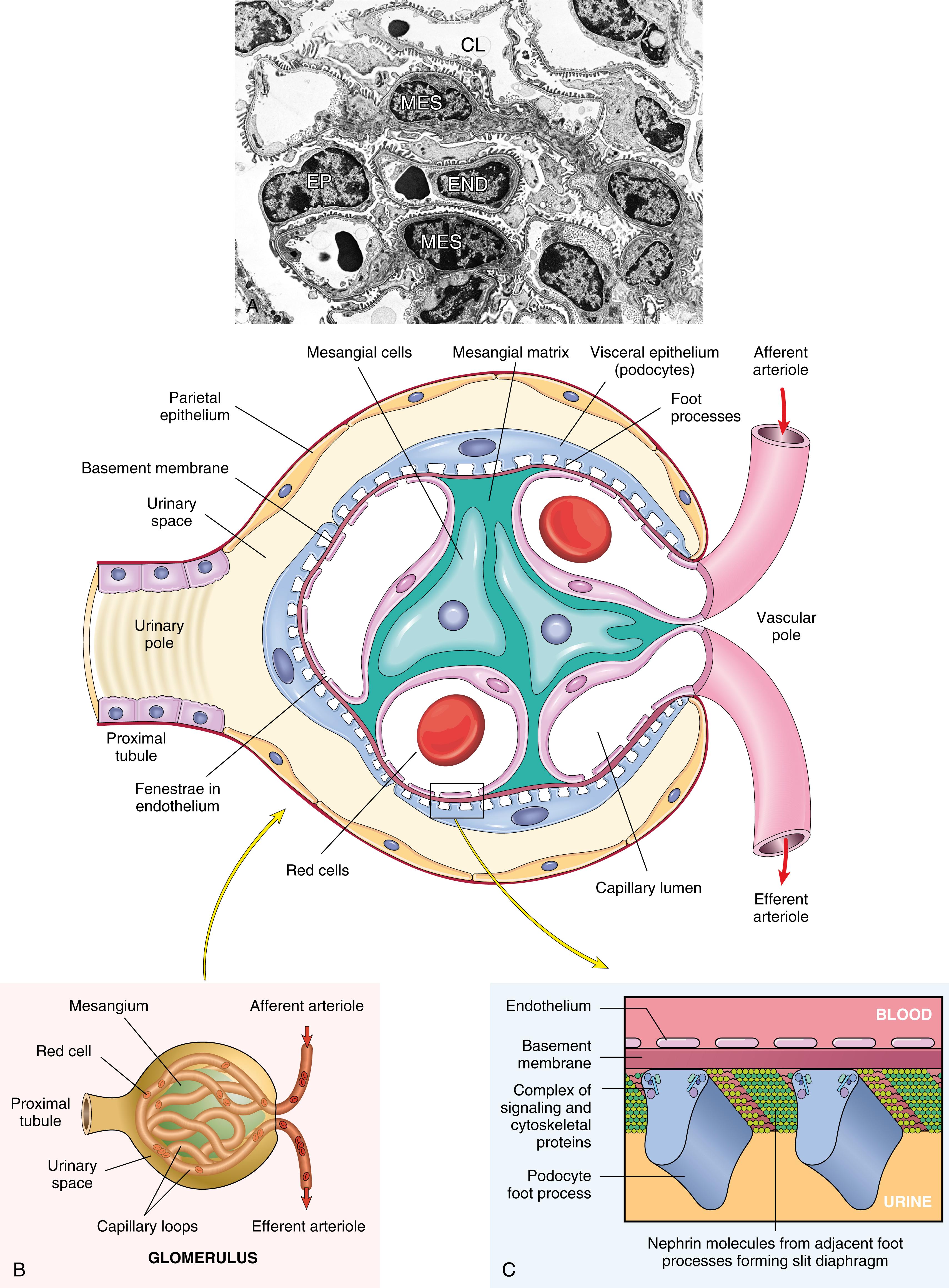
Normally, the glomerular filtration system is permeable to water and small solutes and almost completely impermeable to molecules of the size and molecular charge of albumin (a 70-kDa protein). This selective permeability discriminates among protein molecules mainly according to size (the larger, the less permeable) and charge (the more cationic, the more permeable).
Immune mechanisms underlie most types of glomerular diseases. Antibodies may bind to the GBM by several mechanisms ( Fig. 12.2 ): (1) subendothelial or subepithelial deposition of circulating antigen-antibody complexes; (2) antibodies binding to extrinsic molecules planted within the glomerulus or scattered intrinsic glomerular antigens, producing an appearance of in situ immune complex formation; and (3) anti-GBM antibodies binding to continuously distributed intrinsic GBM antigens. The deposition of immune complexes or antibodies initiates complement and/or Fc receptor mediated inflammation and leukocyte activation ( Chapter 5 ), resulting in glomerular injury that is characteristic of nephritis (nephritic syndrome). In some cases, the antibodies or immune complexes disrupt the glomerular permeability barrier enough to cause the nephrotic syndrome, even without overt inflammation. Subendothelial deposits tend to be associated with greater inflammation, presumably because of easier access of complement proteins and leukocytes from the blood, whereas subepithelial complexes often produce proteinuria with little or no inflammation, possibly because they interfere with the function of the slit diaphragm or epithelial cells. A consistent morphologic finding in all cases of nephrotic syndrome is fusion of epithelial foot processes. It is unclear if this is a cause or an effect of proteinuria.
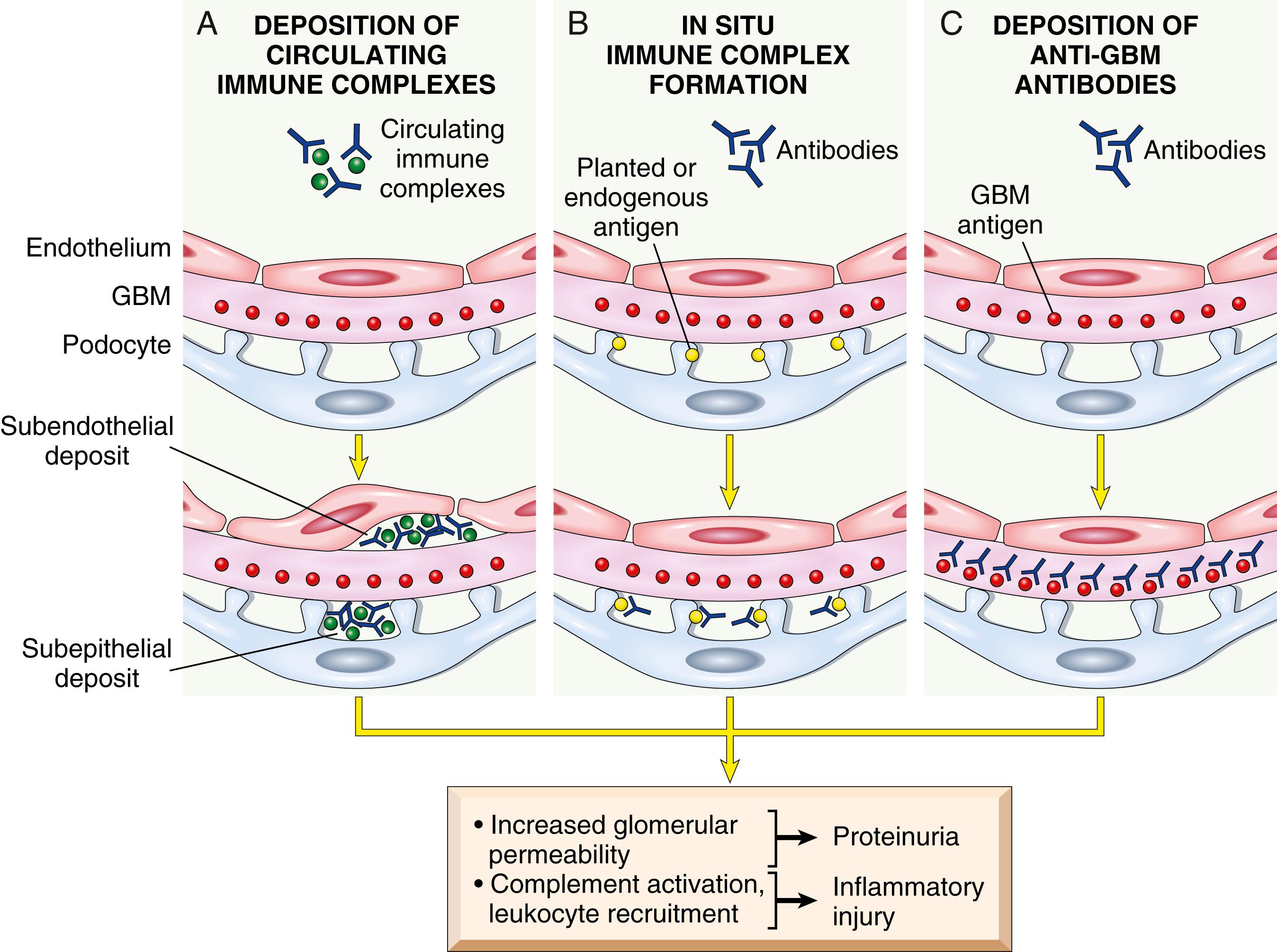
It has long been known that GN may be caused by deposition of preformed immune complexes. Because fluid from the blood passes through the GBM at high pressure (to produce urine) and the GBM is a continuous barrier, it is a common site of deposition of circulating immune complexes. Hence, the kidneys are often involved in systemic immune complex diseases (type III hypersensitivity). Examples include systemic lupus erythematosus, in which the antigens are endogenous nucleoproteins, or the GN that follows certain bacterial (streptococcal), viral (hepatitis B), parasitic ( Plasmodium falciparum malaria), and other infections, in which the antigens are exogenous. Often the inciting antigen is unknown.
The hallmark of immune complex-mediated GN is the appearance of deposits of immunoglobulins and complement, which can be demonstrated by immunofluorescence and electron microscopy. By immunofluorescence microscopy, these deposits appear granular, to which some pathologists give the rather picturesque description of “lumpy-bumpy” ( Fig. 12.3A ). Electron microscopy reveals electron-dense immune deposits in the GBM; these may be subendothelial, subepithelial, or in the mesangium.
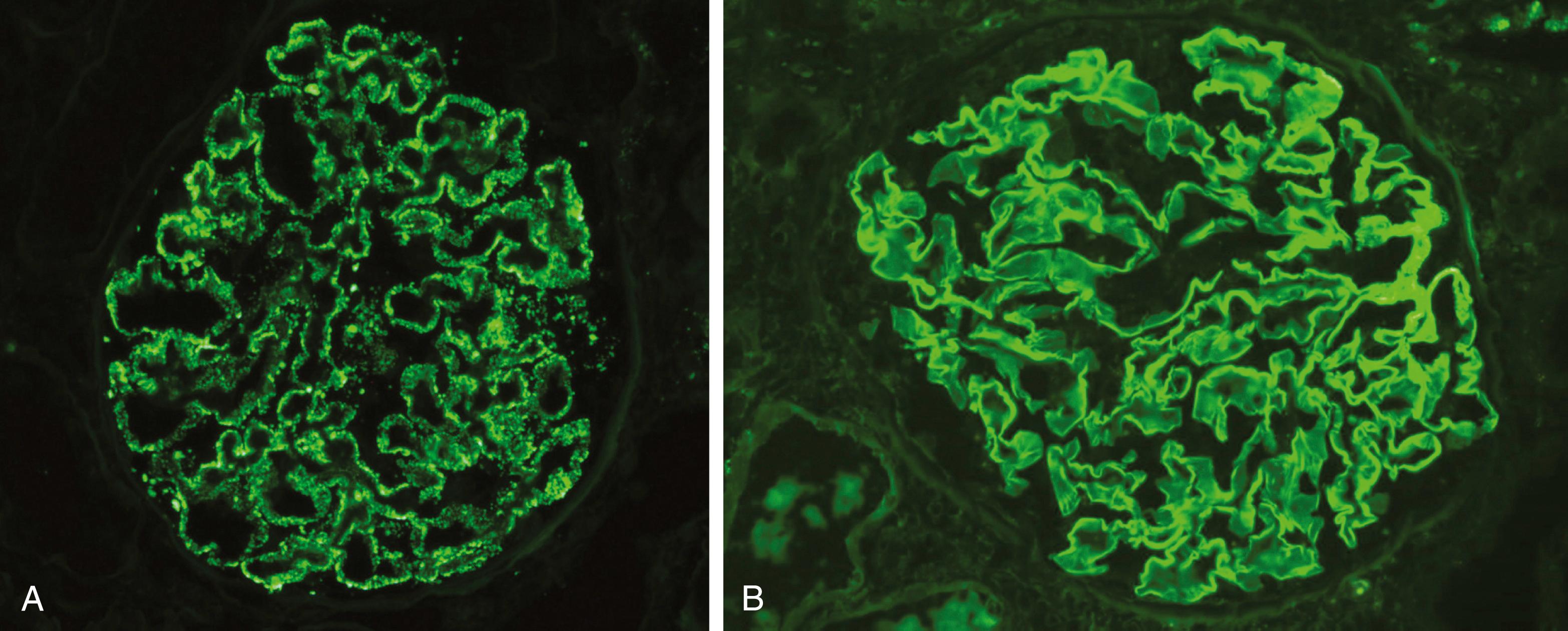
Binding of antibodies to extrinsic molecules planted in the GBM or intrinsic glomerular antigens in a patchy distribution produces the appearance of in situ immune complex formation. In both cases the bound antibodies appear granular by immunofluorescence microscopy. Membranous nephropathy is the classic example of glomerular disease resulting from local formation of immune complexes containing antibodies reactive with endogenous antigens. In this disorder, complexes formed in the subepithelial portion of the GBM cause profound loss of glomerular permeability, resulting in the nephrotic syndrome, with little or no inflammation.
Antibody-mediated GN results from the glomerular deposition of autoantibodies directed against protein components of the GBM. The best-characterized disease in this group is anti-GBM antibody–mediated GN, also known as Goodpasture disease. In this type of injury, antibodies are directed against intrinsic GBM antigens. The distribution of these antigens is continuous, creating a linear pattern of staining when visualized with immunofluorescence microscopy ( Fig. 12.3B ). This form of GN is an example of type II hypersensitivity ( Chapter 5 ).
Several other mechanisms may cause glomerular injury.
Unregulated activation of complement may be triggered by autoantibodies against complement components or inherited abnormalities of complement regulatory proteins. The ensuing complement-mediated injury may affect several tissues, including the kidney. Two forms of GN (dense deposit disease and C3 GN) and one form of a systemic disease with significant renal manifestations (complement-mediated thrombotic microangiopathy, also known as atypical hemolytic uremic syndrome) belong to this category.
Other recruited or intrinsic cells may contribute to glomerular injury. Resident glomerular cells, especially mesangial cells, may be stimulated by antibodies and immune complexes to secrete cytokines and other mediators that can contribute to glomerular inflammation. Activated T lymphocytes have also been implicated in experimental models of glomerular injury, but there is little evidence for this in human diseases. Platelets may aggregate and release mediators, including prostaglandins, growth factors, and TGF-β, which may stimulate collagen deposition (glomerulosclerosis).
Podocyte injury . Because of the role of podocytes in maintaining the permeability barrier of the GBM, injury to these cells is an important cause of glomerular disease. Podocyte injury can be induced by antibodies to podocyte antigens; by toxins; possibly by certain cytokines; or by still poorly characterized circulating factors, as in some cases of focal segmental glomerulosclerosis (discussed later). Podocyte injury produces morphologic changes including effacement of foot processes, vacuolization, and retraction and detachment of cells from the GBM, and the resulting disruption of normal slit diaphragms often results in proteinuria. Inherited mutations in the structural components of slit diaphragms, such as nephrin and podocin, are also associated with functional alterations that lead to rare hereditary forms of nephritis.
Loss of nephrons itself exacerbates glomerular injury. Once renal disease, glomerular or otherwise, destroys sufficient nephrons to reduce the GFR to 30% to 50% of normal, the remaining glomeruli undergo progressive scarring, called glomerulosclerosis, leading eventually to end-stage renal disease. The loss of nephrons triggers adaptive changes to maintain renal function, including glomerular enlargement, and increased blood flow and transcapillary pressure (capillary hypertension). These alterations are ultimately maladaptive, resulting in endothelial and podocyte injury, increased glomerular permeability to proteins (even in the absence of primary glomerular disease), and accumulation of proteins and lipids in the mesangial matrix. Subsequently, there may be capillary obliteration and finally segmental (affecting a portion of a glomerulus) or global (affecting the entire glomerulus) sclerosis of glomeruli. The latter results in further reduction of nephron mass, initiating a cycle of progressive scarring and loss of function.
We now turn to a consideration of specific types of GN and the syndromes they produce ( Table 12.2 ). We divide these diseases into those that primarily cause the nephrotic syndrome and those associated with manifestations of the nephritic syndrome; some diseases do not fit into either category. The diagnosis and classification of glomerular diseases are based largely on morphology, so renal biopsy is a mainstay of the diagnosis and management of these disorders.
| Disease | Most Frequent Clinical Presentation | Pathogenesis | Glomerular Pathology | ||
|---|---|---|---|---|---|
| Light Microscopy | Fluorescence Microscopy | Electron Microscopy | |||
| Minimal change disease | Nephrotic syndrome | Unknown; podocyte injury | Normal | Negative | Effacement of foot processes; no deposits |
| Focal segmental glomerulosclerosis | Nephrotic syndrome; nonnephrotic range proteinuria | Unknown; reaction to loss of renal mass; plasma factor? | Focal and segmental sclerosis and hyalinosis | Usually negative; IgM and C3 may be present in areas of scarring | Effacement of foot processes; epithelial denudation |
| Membranous nephropathy | Nephrotic syndrome | In situ immune complex formation; PLA2R antigen in most cases of primary disease | Diffuse capillary wall thickening and subepithelial “spike” formation | Granular IgG and C3 along GBM | Subepithelial deposits |
| Membranoproliferative glomerulonephritis (MPGN) type I | Nephrotic/nephritic syndrome | Immune complex | Membranoproliferative pattern; GBM splitting | Granular IgG, C3, C1q, and C4 along GBM and mesangium | Subendothelial deposits |
| C3 glomerulopathy (dense deposit disease and C3 glomerulonephritis) | Nephrotic/nephritic syndrome; nonnephrotic proteinuria | Activation of alternative complement pathway; antibody-mediated or hereditary defect in regulation | Mesangial proliferative or membranoproliferative patterns | C3 | Mesangial, intramembranous and subendothelial electron-dense or “waxy” deposits |
| Acute postinfectious glomerulonephritis | Nephritic syndrome | Immune complex mediated; circulating or planted antigen | Diffuse endocapillary proliferation; leukocytic infiltration | Granular IgG and C3 along GBM and mesangium | Primarily subepithelial humps |
| IgA nephropathy | Recurrent hematuria or proteinuria | Immune complexes containing IgA | Mesangial or focal endocapillary proliferative glomerulonephritis | IgA ± IgG, IgM, and C3 in mesangium | Mesangial and paramesangial dense deposits |
| Rapidly progressive glomerulonephritis | Rapid onset of nephritic syndrome, usually with proteinuria; progression to renal failure | Varies: autoantibodies against collagen type IV α3 chain (anti-GBM antibodies); immune complexes; no immune deposits | Extracapillary proliferation with crescents; necrosis | Linear or granular IgG and C3; fibrin in crescents | Immune complexes or no deposits; GBM disruptions; fibrin |
Many primary glomerular diseases cause the nephrotic syndrome, but in adults this syndrome is most often secondary to diabetes, amyloidosis, and systemic lupus erythematosus ( Table 12.3 ). The renal lesions produced by amyloidosis are discussed in Chapter 5 and those caused by diabetes in Chapter 18 . Because of the great increase of type 2 diabetes associated with obesity, diabetic nephropathy is now the most common cause of chronic kidney disease in the United States. Here we discuss primary glomerular diseases.
| Cause | Prevalence (%) a | |
|---|---|---|
| Children | Adults | |
| Primary Glomerular Disease | ||
| Minimal change disease | 65 | 10 |
| Focal segmental glomerulosclerosis | 10 | 35 |
| Membranous nephropathy | 5 | 30 |
| Membranoproliferative glomerulonephritis | 10 | 10 |
| IgA nephropathy and others | 10 | 15 |
| Systemic Diseases With Renal Manifestations | ||
| Diabetes | ||
| Amyloidosis | ||
| Systemic lupus erythematosus | ||
| Drug ingestion (e.g., gold, penicillamine, heroin) | ||
| Infections (e.g., malaria, syphilis, hepatitis B, HIV) | ||
| Malignancy (e.g., carcinoma, melanoma) | ||
| Miscellaneous (e.g., bee sting allergy, hereditary nephritis) | ||
a Approximate prevalence of primary disease is 95% of the cases in children and 60% in adults. Approximate prevalence of systemic disease is 5% of the cases in children and 40% in adults.
Minimal change disease, a relatively benign disorder, is the most frequent cause of the nephrotic syndrome in children and is characterized by glomeruli that have a normal appearance by light microscopy. It may develop at any age but is most common between 1 and 7 years of age. In most cases it is idiopathic, but it is also seen in association with certain infections, therapeutic drugs, and neoplasms.
The leading hypothesis for the pathogenesis of minimal change disease is that circulating molecules injure podocytes and cause proteinuria secondary to foot process effacement. Since foot process effacement is common to many causes of nephrotic syndrome, it is not entirely clear whether it is the primary lesion or is secondary to proteinuria. An immune mechanism is suspected mainly because of the clinical response to steroids. Although there are reports of “permeability factors” secreted by patients' lymphocytes and other cells, none has been characterized biochemically or established as being causative. Recent work points to a potential pathogenic role for antibodies against slit diaphragm proteins, but this also remains to be proven. Thus, the pathogenesis of the disease remains unknown.
The glomeruli are histologically normal (accounting for the name of the disease), and no deposits of antibody or complement are seen by immunofluorescence ( Fig. 12.4A ). The cells of the proximal convoluted tubules often are heavily laden with protein droplets and lipids due to tubular reabsorption of the molecules that have leaked through the diseased glomeruli. The only morphologic glomerular abnormality is the diffuse effacement of podocyte foot processes, visible by electron microscopy ( Fig. 12.4B ). Other ultrastructural changes in podocytes include vacuolization, microvillus formation, and occasional focal detachments, suggesting some form of podocyte injury. Steroid therapy reverses these podocyte alterations, and proteinuria remits concomitantly.
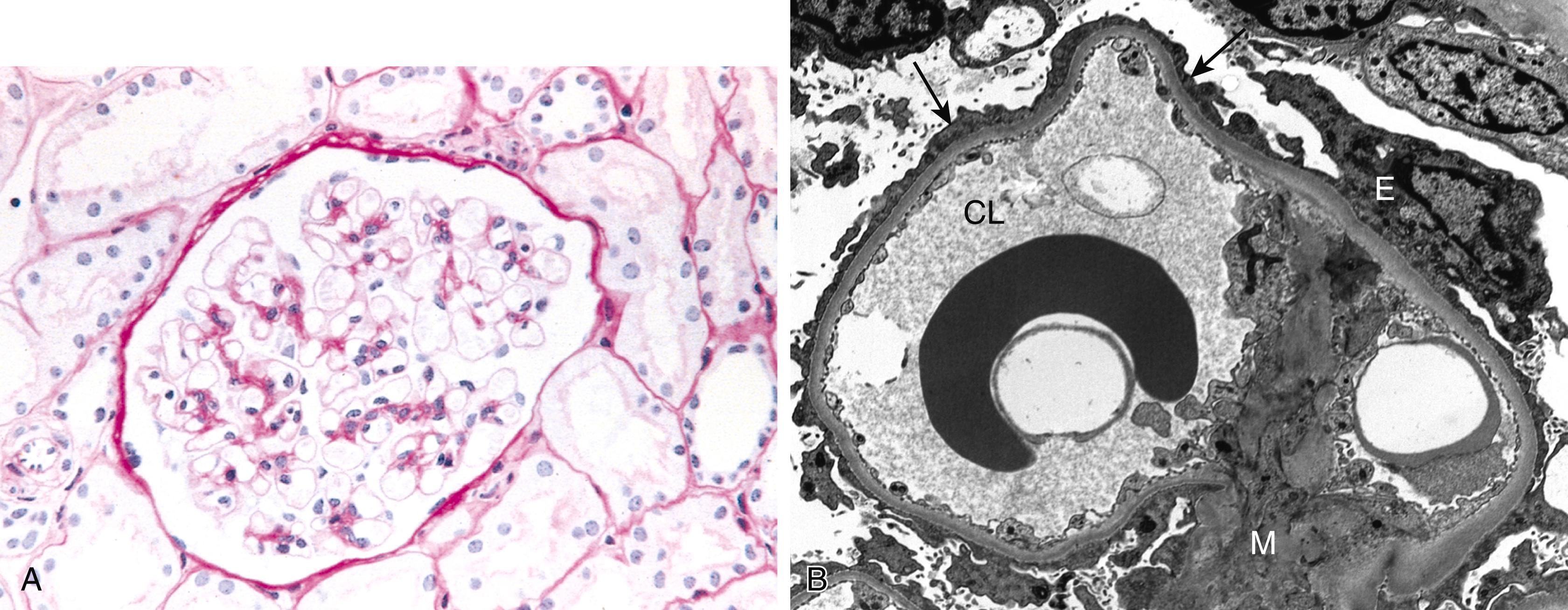
The disease typically manifests with abrupt development of the nephrotic syndrome in an otherwise healthy child. Renal function is usually preserved. The protein loss affects mainly smaller plasma proteins, chiefly albumin (selective proteinuria). The prognosis for children with this disorder is favorable. More than 90% of children respond to a short course of corticosteroid therapy; however, proteinuria recurs in more than two-thirds of the initial responders, and some of these individuals become steroid dependent. Less than 5% develop chronic kidney disease over time, most often focal segmental glomerulosclerosis (FSGS), suggesting that minimal change disease and FSGS are stages in a continuum of progressive glomerular disease. Because of its responsiveness to therapy in children, minimal change disease must be differentiated from other causes of the nephrotic syndrome. Adults with this disease also respond to steroid therapy, but the response is slower than in children and relapses are more common.
Focal segmental glomerulosclerosis (FSGS) is characterized by sclerosis of some (but not all) glomeruli (focal) that involves only a part of each affected glomerulus (segmental). It is not a specific disease entity but a pattern of injury that is often found in adults and children with the nephrotic syndrome. Several forms of FSGS are recognized.
Primary, with no identifiable predisposing cause. Primary FSGS accounts for about 30% of all cases of the nephrotic syndrome in the United States. It is a frequent cause of nephrotic syndrome in children and an increasingly common cause in adults. It is also the primary glomerular disorder that most commonly progresses to end-stage renal disease in the United States.
Secondary to diverse insults, including the following:
A maladaptive response to nephron loss . Loss of functional renal mass may result from any form of chronic kidney disease. It is also seen in severely obese patients who develop proteinuria. In all these conditions, there is increased filtration pressure in residual glomeruli, and this is believed to result in FSGS.
Infections . FSGS is seen in 5% to 10% of patients infected with HIV; however, the incidence is decreasing with improved antiviral therapy.
Drug use , specifically heroin use, and, less commonly, various therapeutic agents.
Genetic. The inherited forms vary in incidence in different populations and usually have an autosomal recessive pattern of inheritance. Over 60 genes have been implicated, some of which encode proteins involved in podocyte function, such as nephrin, podocin, and cytoskeletal proteins.
Injury to podocytes is the likely initiating event of primary FSGS. Injury may manifest initially as foot process fusion, associated with increased glomerular permeability, and may progress to loss of podocytes and slit diaphragms. The source of the injury remains unknown. As with minimal change disease, permeability-inducing factors produced by lymphocytes have been proposed, but they remain undefined. The recurrence of proteinuria in some patients following renal transplantation for FSGS, sometimes within a day or less, supports the idea that a circulating mediator leads to podocyte damage. Entrapment of plasma proteins and lipids and ECM deposition in glomeruli lead to obliteration of the capillaries and consequent glomerulosclerosis.
Primary FSGS initially affects the juxtamedullary glomeruli, but with progression, most glomeruli may be affected. The lesions involve some tufts within a glomerulus while sparing others ( Fig. 12.5 ). The affected glomerular segments exhibit obliterated capillary lumina, increased mesangial matrix, deposition of hyaline material, and foamy (lipid-laden) macrophages. Immunofluorescence microscopy often reveals nonspecific trapping of immunoglobulins, usually IgM, and complement in the areas of sclerosis. On electron microscopy, the podocytes exhibit effacement of foot processes. With time, progression leads to global sclerosis of the glomeruli, pronounced tubular atrophy, and interstitial fibrosis, which, in advanced disease, is difficult to differentiate from other forms of chronic glomerular disease.

A morphologic variant called collapsing glomerulopathy is characterized by collapse of the glomerular tuft and epithelial cell hyperplasia. This is a more severe manifestation of FSGS that carries a particularly poor prognosis.
FSGS must be distinguished from minimal change disease because the clinical course and response to therapy are markedly different. Both are associated with the nephrotic syndrome, but the incidence of hematuria and hypertension is higher in individuals with FSGS. Also, unlike minimal change disease, FSGS-associated proteinuria is nonselective, and in general the response to corticosteroid therapy is poor. At least 50% of patients with FSGS develop end-stage renal disease within 10 years of diagnosis.
Membranous nephropathy is characterized by subepithelial deposits of antigen-antibody complexes along the GBM. It usually presents in adults between the ages of 30 and 60 years and follows an indolent and slowly progressive course.
Up to 80% of cases of membranous nephropathy are primary, caused by autoantibodies against podocyte antigens. In the remainder, the disease is secondary to other conditions, including the following:
Infections (e.g., chronic hepatitis B, syphilis, schistosomiasis, malaria)
Malignant neoplasms, particularly carcinomas of various sites and B cell tumors such as chronic lymphocytic leukemia
Autoimmune diseases, particularly systemic lupus erythematosus
Exposure to inorganic salts (gold, mercury)
Drugs (e.g., penicillamine, captopril, nonsteroidal antiinflammatory agents)
Primary membranous nephropathy is an autoimmune disease in which autoantibodies form in situ immune complexes usually with endogenous glomerular antigens. Circulating autoantibodies against the podocyte antigen phospholipase A 2 receptor (PLA2R) are present in 70% to 80% of patients, and in the rest, antibodies against several other glomerular antigens have been detected, but it is not established if any of these are causative. Complement proteins are also detected; however, the mechanism for complement activation is unclear since the most common autoantibody is of the IgG4 isotype, which is a poor activator of the classical complement pathway.
The main histologic feature of membranous nephropathy is diffuse thickening of the capillary wall ( Fig. 12.6A ). Immunofluorescence microscopy shows granular deposits of immunoglobulins and complement along the GBM ( Fig. 12.6B ). By electron microscopy, the thickening is seen to be caused by subepithelial deposits between the GBM and epithelial cells; the intervening small protrusions of GBM matrix produce a spike and dome pattern (see Fig. 12.6B ). As the disease progresses, the spikes enclose the deposits, which become incorporated into the GBM. In addition, as in other causes of nephrotic syndrome, the podocytes show effacement of foot processes. With further progression, glomeruli may become sclerosed.
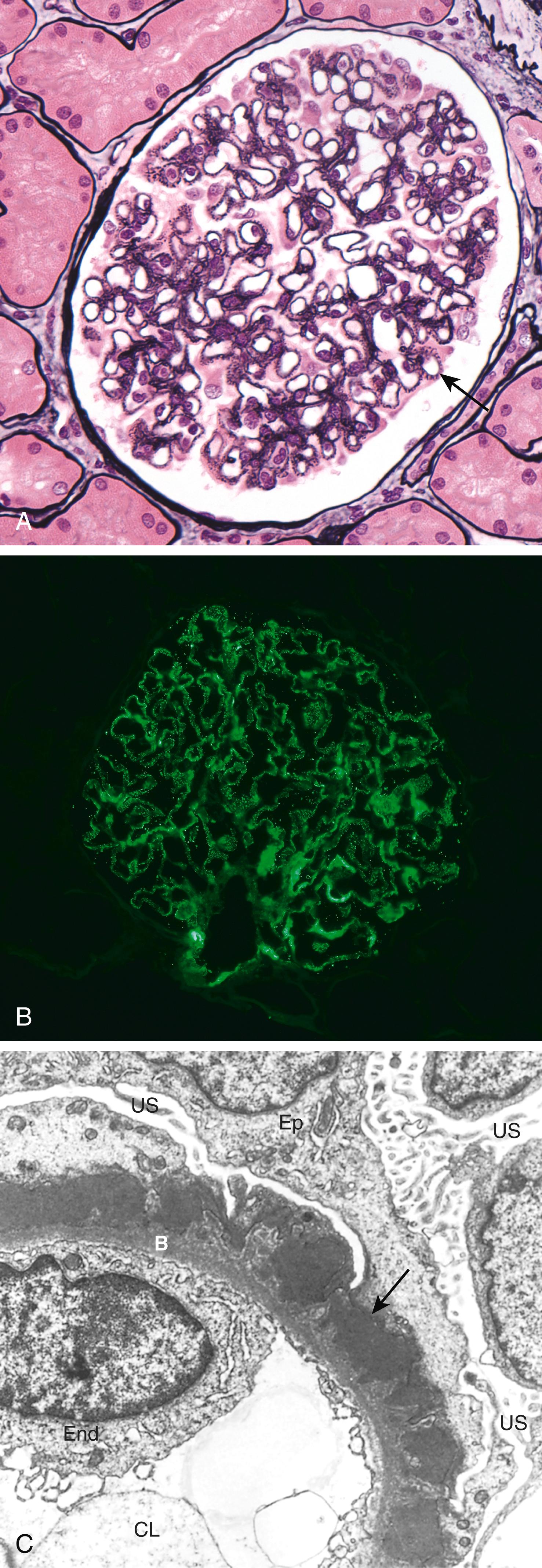
Most cases of membranous nephropathy present as nephrotic syndrome, usually without antecedent illness. In contrast to minimal change disease, the proteinuria is nonselective and usually fails to respond to corticosteroid therapy. Serologic detection of anti-PLA2R is helpful in making a diagnosis and the titer is useful in monitoring response to therapy. Membranous nephropathy follows a notoriously variable and often indolent course. Overall, although proteinuria persists in greater than 60% of patients, only about 40% progress to renal failure over a period of 2 to 20 years. An additional 10% to 30% of cases have a more benign course with partial or complete remission of proteinuria.
Membranoproliferative GN (MPGN) is a pattern of glomerular injury characterized by thickening of the GBM and mesangial hypercellularity. It accounts for 5% to 10% of cases of idiopathic nephrotic syndrome in children and adults. In the past, MPGN was subclassified into two types (I and II) on the basis of distinct pathologic findings. These are now recognized to be distinct entities, termed MPGN type I, which is defined by the presence of immune complexes, and dense deposit disease (formerly MPGN type II ), in which there is complement activation without immune complexes. MPGN type I is far more common (about 80% of cases) and is the focus here. Dense deposit disease will be discussed later along with the related condition of C3 glomerulonephritis.
Type I MPGN may be caused by deposition of circulating immune complexes or by in situ immune complex formation with a planted antigen with activation of both classical and alternative complement pathways. In many cases, an underlying disorder can be identified, such as infection (e.g., hepatitis B and C), autoimmune disease (e.g., SLE), or monoclonal gammopathy. The disease is idiopathic in a minority of patients.
By light microscopy the glomeruli are large and show hypercellularity caused by proliferation of mesangial cells and capillary endothelial cells and by infiltrating leukocytes; these changes often accentuate the glomerular lobules ( Fig. 12.7A ). The GBM is thickened, and the glomerular capillary wall often shows a double contour, or “tram track,” appearance. This “splitting” of the GBM is due to its disruption by interposed mesangial and inflammatory cells and the deposition of mesangial matrix and immune complexes. By immunofluorescence microscopy, granular deposits of IgG and complement proteins are often present ( Fig. 12.7B ). By electron microscopy, discrete deposits are seen in the GBM and occasionally in the mesangium ( Fig. 12.7C ).
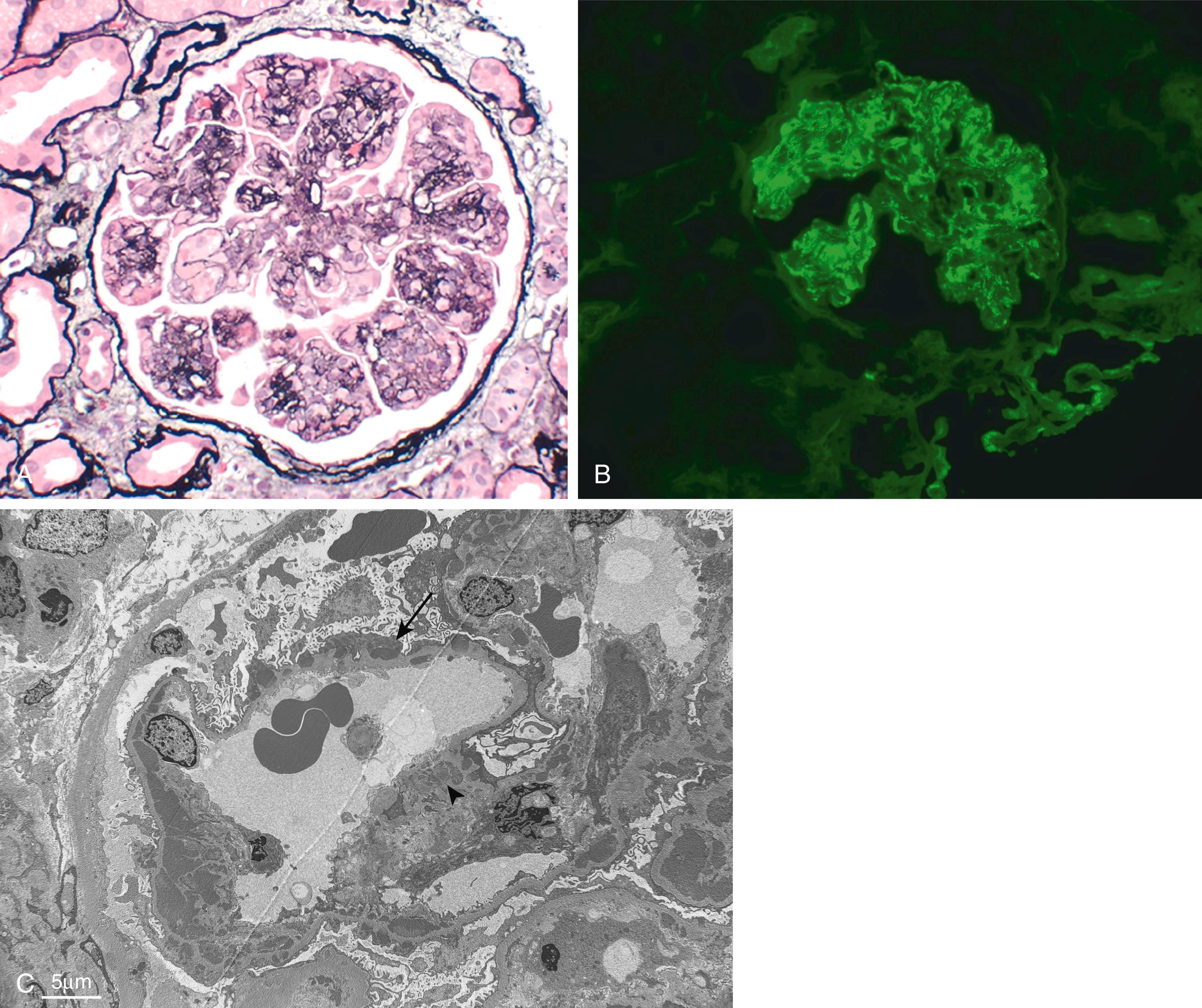
Most patients with primary MPGN present as adolescents or young adults with hematuria and varying degrees of proteinuria. The disease usually follows a slowly progressive, unremitting course. Treatment with steroids, immunosuppressive agents, and antiplatelet drugs has not proven to be of any benefit. MPGN may also occur in association with other disorders (secondary MPGN), such as systemic lupus erythematosus, hepatitis B and C, chronic liver disease, and chronic bacterial infections. Indeed, many so-called “idiopathic” cases are believed to be associated with hepatitis C and related cryoglobulinemia. These secondary cases of MPGN are more common in adults; treatment of the underlying disease may resolve the kidney lesions.
The term C3 glomerulopathy encompasses two conditions characterized by excessive activation of the complement system, dense deposit disease (formerly called MPGN type II ), in which deposits are seen in the GBM by electron microscopy, and C3 glomerulonephritis , in which deposits are less prominent. These are rare diseases with shared clinical, morphologic, and pathogenic features that may represent a spectrum of injury.
Complement dysregulation due to acquired or hereditary abnormalities of the alternative pathway of complement activation is the underlying cause of dense deposit disease and C3 GN. Some patients have an activating autoantibody against C3 convertase, called C3 nephritic factor (C3NeF), that causes uncontrolled cleavage of C3 by the alternative complement pathway. In other patients, autoantibodies to or mutations in various complement regulatory proteins, such as Factor H, Factor I, and membrane cofactor protein (MCP) are the cause of unregulated activation of the alternative pathway of complement.
Although glomerular changes in dense deposit disease and C3 GN vary from relatively subtle to severe, the classic light microscopic presentation is similar to that seen in MPGN type I. The glomeruli are hypercellular, the capillary walls show duplicated basement membranes, and the mesangial matrix is increased ( Fig. 12.8A ). By immunofluorescence microscopy, in both dense deposit disease and C3 GN there is mesangial and glomerular capillary wall staining for C3 ( Fig. 12.8B ). IgG and the early components of the classical complement pathway (C1q and C4) are usually absent in both conditions. By electron microscopy, in C3 GN there are mesangial and subendothelial electron-dense “waxy” deposits ( Fig. 12.8C ). By contrast, in the aptly named dense deposit disease, the GBM is transformed into an irregular, ribbonlike, electron-dense structure, resulting from the deposition of C3-containing material ( Fig. 12.8D ).
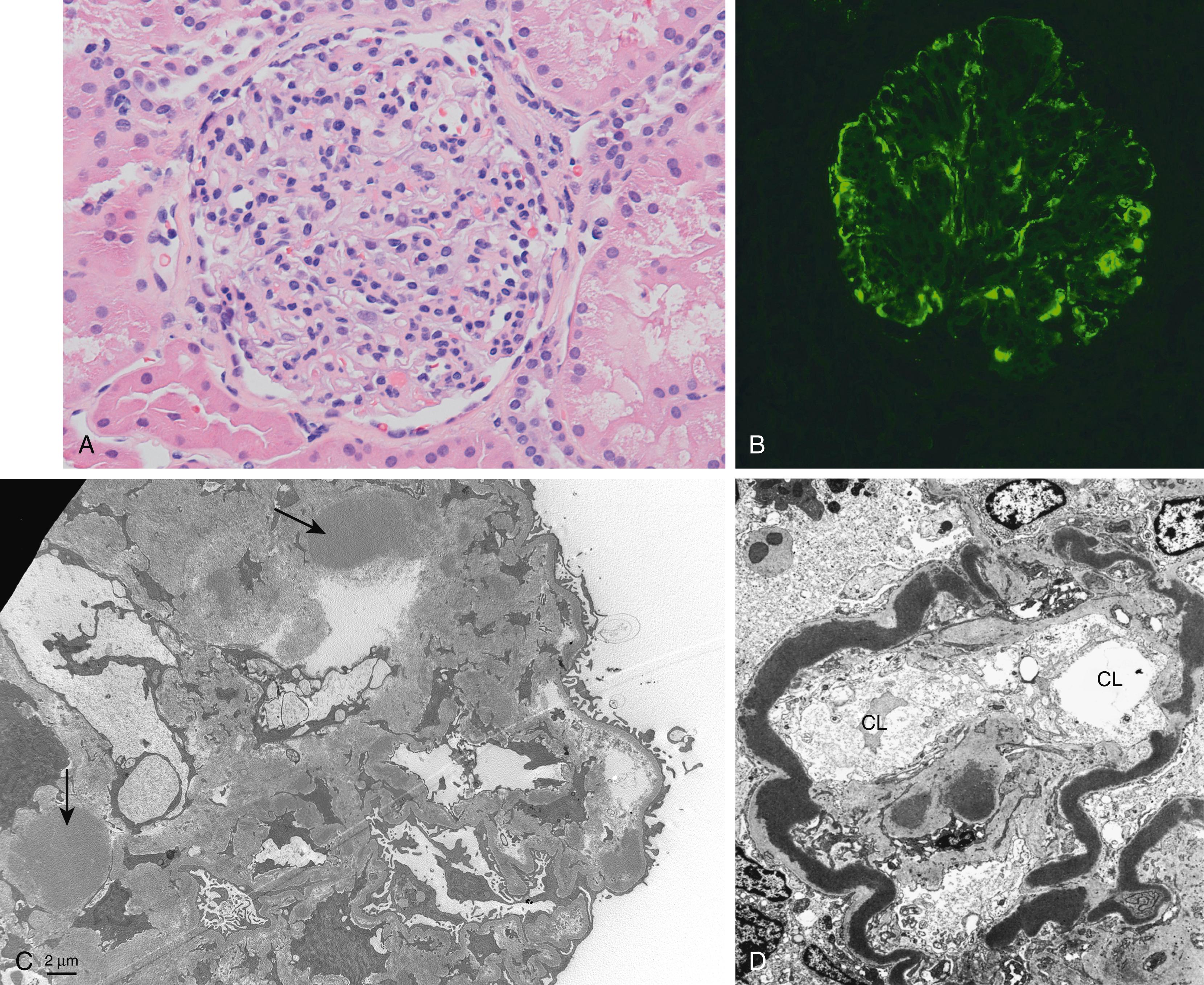
Dense deposit disease is usually seen in children and young adults, whereas C3 GN is more common in adults. In both diseases, patients present with variable proteinuria or hematuria and usually mild azotemia. Serum C3 levels are typically reduced. Both diseases carry a poor prognosis and almost one-third of patients progress to end-stage renal failure. The diseases tend to recur in up to 85% of patients after renal transplantation.
Glomerular diseases that present with the nephritic syndrome are usually associated with significant inflammation in the glomeruli, which damages capillary walls, leading to leakage of red cells (hematuria), and decreased GFR, which results in oliguria and azotemia.
Acute postinfectious GN is characterized by glomerular deposition of immune complexes resulting in inflammation and damage to glomeruli. The classic pattern is seen in poststreptococcal GN, but other bacterial infections, such as pneumococcus and staphylococcus, as well as viral infections, such as mumps, measles, chickenpox, and hepatitis B and C, may be the inciting event. The incidence of the disease has decreased in higher-income countries because of antibiotic treatment of the initial infection, and more than 90% of cases are now seen in lower-income countries.
Postinfectious GN is caused by glomerular deposition of immune complexes consisting of microbial antigens and specific antibodies, resulting in complement activation by the classical pathway and subsequent inflammation. In children, it most often follows infection by certain “nephritogenic” strains of β-hemolytic streptococci. Streptococcal antigens implicated in the formation of the complexes include streptococcal exotoxin B, a highly immunogenic protein that has been detected in the GBM deposits. In older adults, GN may develop following and even concurrent with active staphylococcal infection. Typical features of immune complex disease, such as hypocomplementemia and granular deposits of IgG and complement on the GBM, are seen. The immune complexes may be preformed circulating complexes of streptococcal antigens and antibodies that deposit in the GBM or may be formed in situ by antibody binding to streptococcal antigens deposited in the GBM.
By light microscopy, the most characteristic change in postinfectious GN is increased cellularity of the glomerular tufts that affects nearly all glomeruli—hence the term diffuse GN ( Fig. 12.9A ). The increased cellularity is caused by proliferation of endothelial and mesangial cells and by infiltrating neutrophils and monocytes. Sometimes there is necrosis of the capillary walls. In a few cases, crescents (discussed later) may be observed within the urinary space, formed in response to the severe injury. Immunofluorescence studies reveal granular deposits of IgG and complement within the capillary walls and some mesangial areas ( Fig. 12.9B ). Electron microscopy shows subendothelial, intramembranous, or, most often, subepithelial deposits nestled against the GBM forming “humps” ( Fig. 12.9C ). These deposits are usually cleared over a period of about 2 months after resolution of the infection.
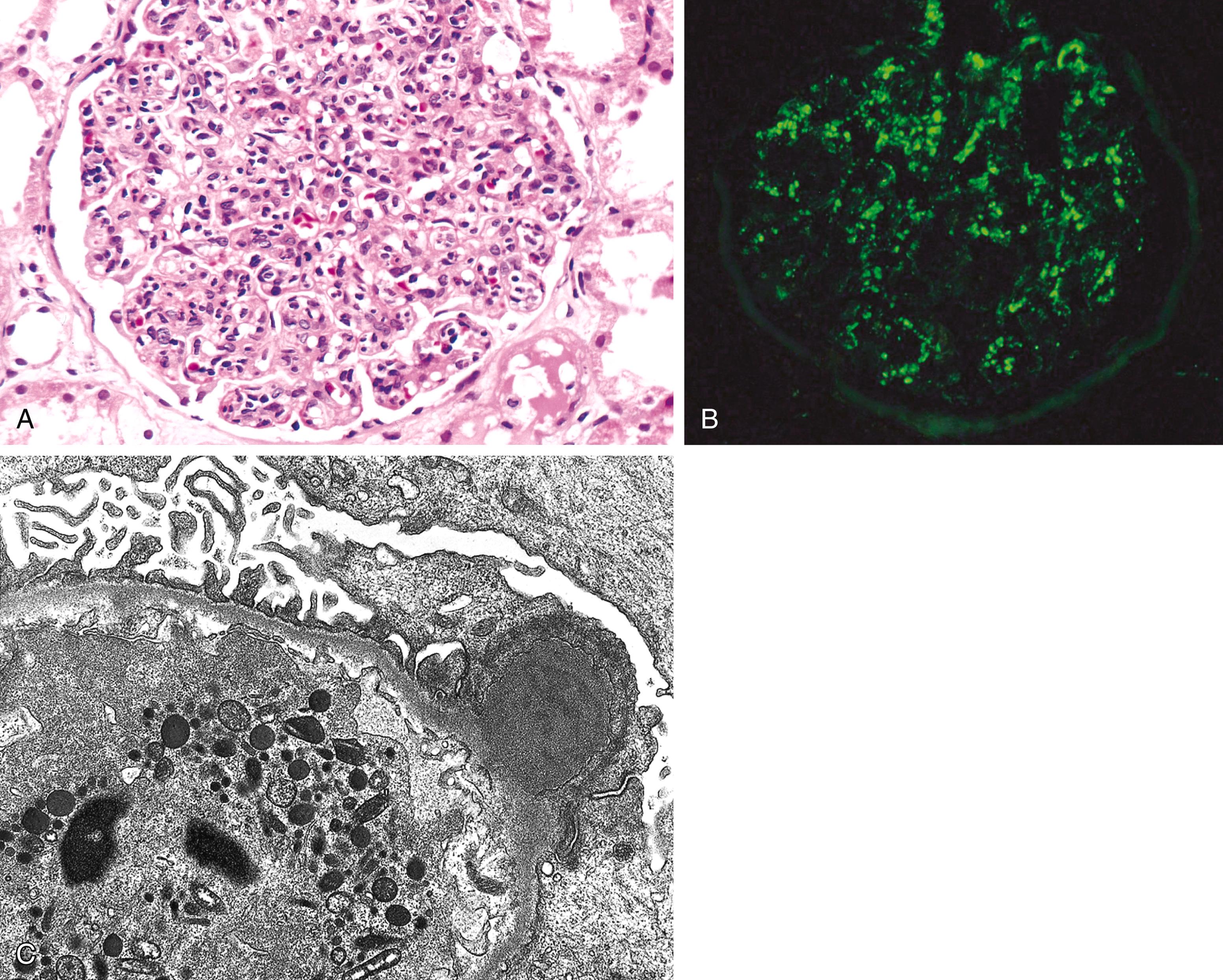
Poststreptococcal GN is a representative example of postinfectious GN. The typical case develops in a child 1 to 4 weeks after recovery from a group A streptococcal infection, but in rare instances the disease develops during the infection. In most cases, the initiating infection is localized to the pharynx or skin. The clinical presentation varies from asymptomatic to mild hematuria to acute nephritic syndrome with edema, hypertension, and mild to moderate azotemia. Some degree of proteinuria is often present, and it is occasionally severe enough to produce the nephrotic syndrome. Serum complement levels are low during the active phase of the disease, and serum anti–streptolysin O antibody titers are elevated in poststreptococcal cases.
More than 95% of affected children eventually recover renal function, but some develop rapidly progressive GN owing to severe injury with crescent formation (see later), or chronic renal disease from secondary scarring. In adults, the prognosis is more guarded, with 15% to 50% of affected individuals developing chronic renal disease over a few years or 1 to 2 decades, depending on the clinical and histologic severity.
Rapidly progressive GN (RPGN) is a clinical syndrome with diverse etiologies characterized by acute renal failure, features of the nephritic syndrome, and often severe oliguria. In many cases, renal biopsy reveals the presence of glomerular crescents; hence, the disease is also called crescentic GN.
In most cases, the glomerular injury of RPGN is immunologically mediated. Three forms are recognized:
Anti-GBM antibody–mediated crescentic GN (Goodpasture disease) is characterized by linear deposits of IgG and, in many cases, C3, in the GBM (type II hypersensitivity, Chapter 5 ). In some patients, the anti-GBM antibodies also bind to pulmonary alveolar capillary basement membranes and lead to pulmonary hemorrhages, which, when associated with renal failure, is known as Goodpasture syndrome ( Chapter 11 ).
Immune complex–mediated crescentic GN may complicate any of the immune complex nephritides, including postinfectious GN, systemic lupus erythematosus, IgA nephropathy, and Henoch-Schönlein purpura. In other cases, immune complexes are demonstrated but the underlying cause is undetermined. This type of RPGN frequently shows cellular proliferation and influx of leukocytes within the glomerular tuft (proliferative GN), in addition to crescent formation. A consistent finding is the characteristic granular pattern of staining of the GBM and/or mesangium for immunoglobulin and/or complement on immunofluorescence studies.
Pauci-immune crescentic GN is defined by the lack of detectable anti-GBM antibody or immune complex deposition. The presence of circulating antineutrophil cytoplasmic antibodies (PR3-ANCA) in some cases of crescentic GN suggests that these are a component of a systemic vasculitis ( Chapter 8 ). In many cases, however, pauci-immune crescentic GN is idiopathic.
The light microscopic changes are similar in various forms of crescentic GN. The glomeruli show cellular proliferation outside the capillary loops, sometimes in association with segmental capillary necrosis, breaks in the GBM, and deposition of fibrin in Bowman’s space. The distinctive lesions outside the capillary loops are called crescents owing to their shape as they fill Bowman’s space. Crescents are formed both by proliferation of parietal epithelial cells and by migration of monocytes and other leukocytes ( Fig. 12.10A ). In addition to crescents, cellular proliferation is seen within the capillary loops and/or in the mesangial areas in cases with immune complex-mediated pathogenesis. Immunofluorescence studies reveal the characteristic strong linear staining with IgG and C3 along the GBM in anti-GBM antibody-mediated disease (see Fig. 12.3B ), a granular pattern of glomerular staining in immune complex-mediated GN, and no staining in pauci-immune GN. Electron microscopy shows electron-dense immune complex deposits within the glomeruli in immune complex–mediated GN. Electron microscopy may show ruptures in the GBM, signifying severe glomerular injury ( Fig. 12.10B ). The crescents eventually obliterate Bowman’s space and over time may undergo scarring, resulting in progressive glomerulosclerosis.
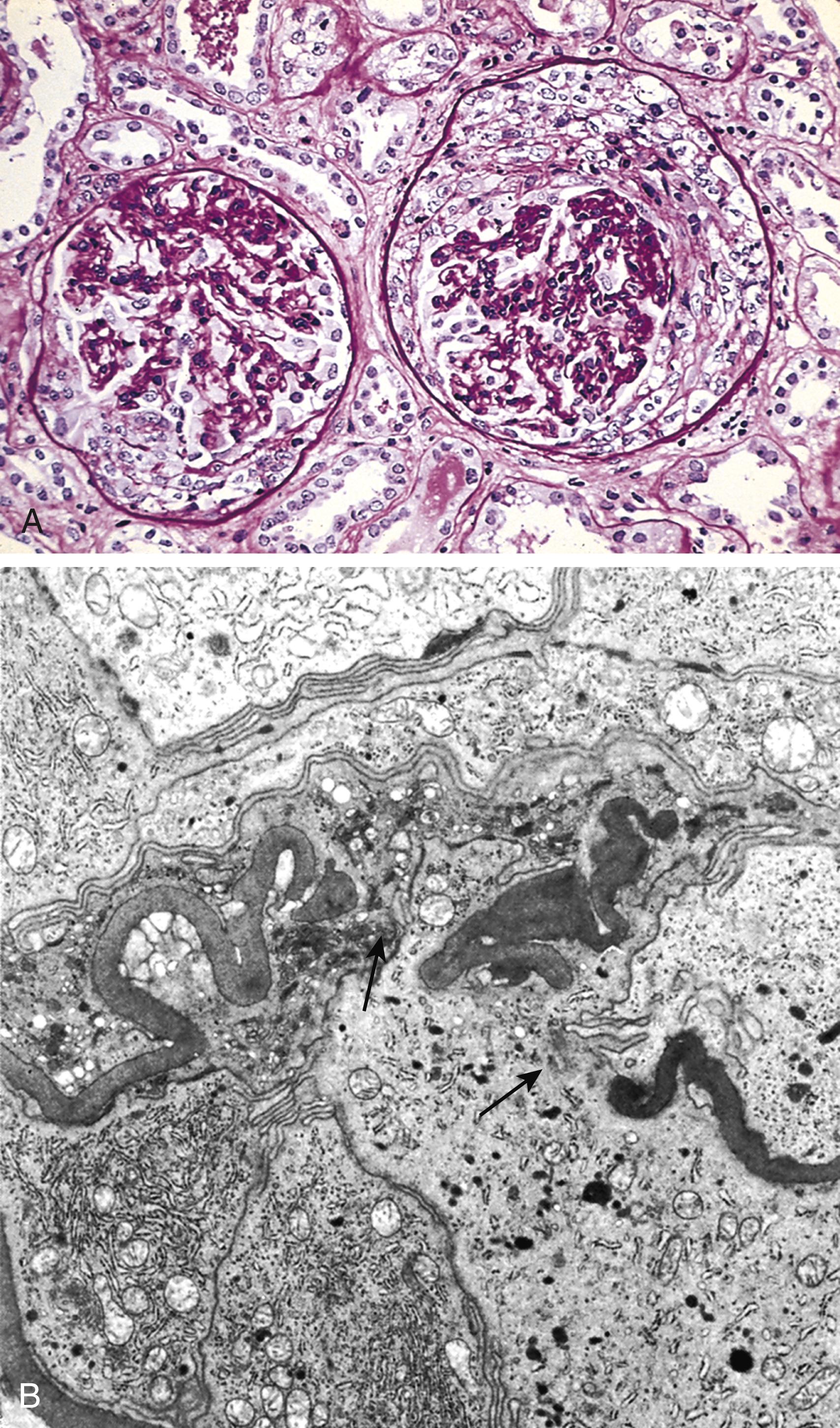
The onset of RPGN resembles other causes of the nephritic syndrome, but oliguria and azotemia are more pronounced. Proteinuria sometimes approaching the nephrotic range may occur. Some affected individuals become anuric and require long-term dialysis or transplantation. If untreated, RPGN can lead to renal failure within a period of weeks to months. The prognosis is roughly correlated to the fraction of involved glomeruli (patients in whom crescents are present in less than 80% of the glomeruli have a more favorable prognosis), and the severity of renal failure at diagnosis. All forms are treated with immunosuppressive agents; plasmapheresis may also benefit those with anti-GBM antibody GN and ANCA-related pauci-immune crescentic GN.
Systemic lupus erythematosus (SLE) is an autoimmune disease in which patients make autoantibodies against their own nuclear proteins and many other self antigens. The pathogenesis, lesions, and clinical features of the disease are discussed in Chapter 5 . Much of the pathology is caused by immune complexes composed of nuclear antigens and specific antibodies; in fact, SLE is the prototype of a human systemic immune complex disease (type III hypersensitivity, Chapter 5 ). Glomeruli are the major site of deposition of immune complexes and bear the brunt of the lesions; the renal involvement in SLE is discussed here.
According to the currently accepted classification, six patterns of glomerular disease are recognized in lupus nephritis. There is overlap within these classes and lesions may evolve from one class to another over time. Thus, the exact percentage of patients with each of the six classes of lesions is difficult to determine; suffice it to say that class I is least common and class IV is most common.
Minimal mesangial lupus nephritis (class I) is very uncommon and is characterized by immune complex deposition in the mesangium, identified by immunofluorescence and by electron microscopy, but without structural changes by light microscopy. This pattern is not diagnosed often because patients are usually asymptomatic and have normal urinalysis results and serum creatinine levels, so biopsy is rarely done.
Mesangial proliferative lupus nephritis (class II) is characterized by mesangial cell proliferation, often accompanied by accumulation of mesangial matrix, and granular mesangial deposits of immunoglobulin and complement without involvement of glomerular capillaries. These patients may have proteinuria or microscopic hematuria but almost never develop nephrotic syndrome or renal failure.
Focal lupus nephritis (class III) is defined by involvement of fewer than 50% of all glomeruli. The lesions may be segmental or global. Affected glomeruli may exhibit swelling and proliferation of endothelial and mesangial cells associated with leukocyte accumulation, capillary necrosis, and hyaline thrombi. Often, there is extracapillary proliferation associated with focal necrosis and crescent formation ( Fig. 12.11A ). The clinical presentation ranges from mild hematuria and proteinuria to acute renal insufficiency. Red cell casts in the urine are common when the disease is active. Some patients progress to diffuse glomerulonephritis. The active inflammatory lesions can heal completely or lead to chronic global or segmental glomerular scarring.
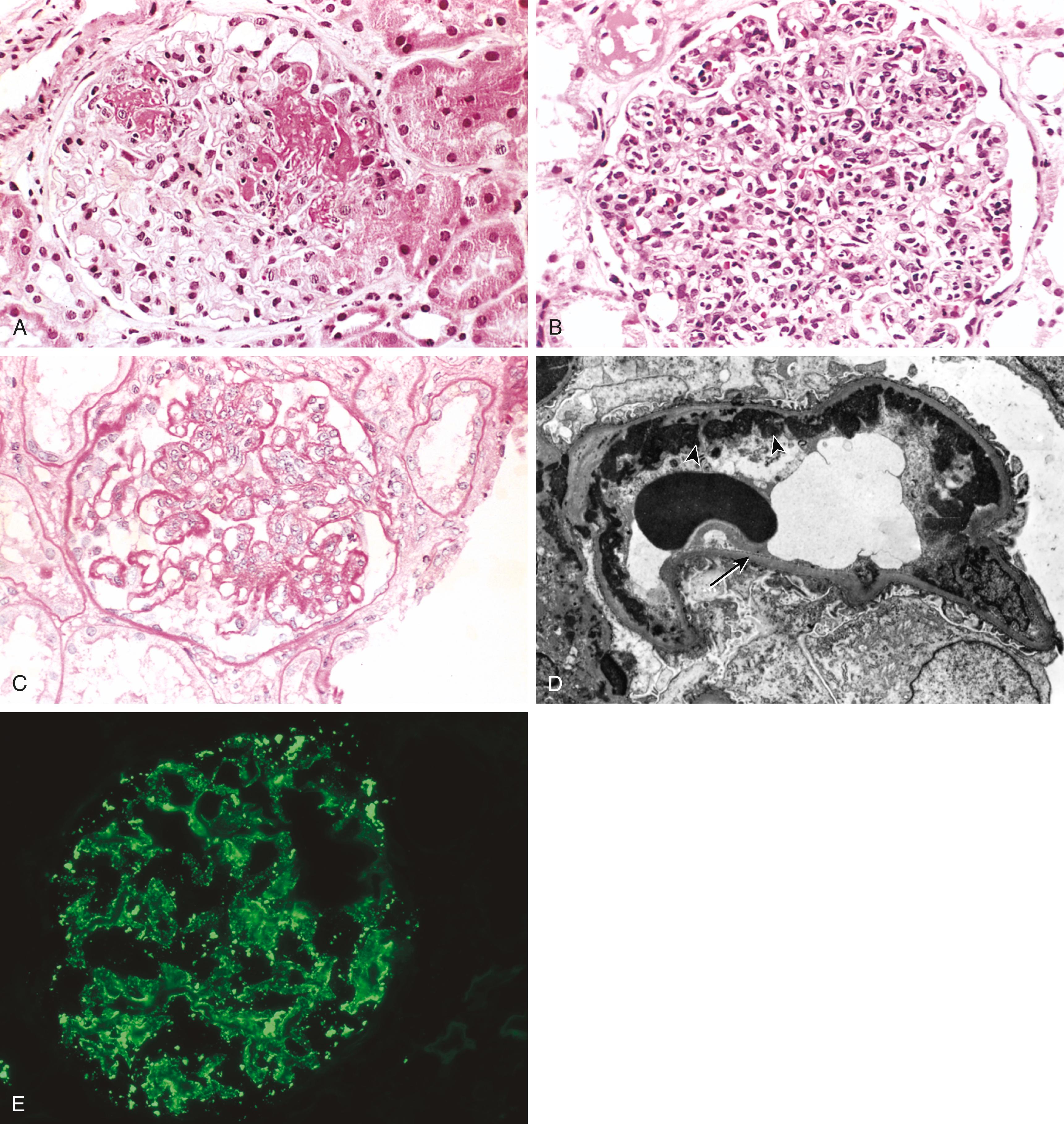
Diffuse lupus nephritis (class IV) is the most common and most severe form of lupus nephritis. The lesions are identical to those in class III but differ in extent; in diffuse lupus nephritis, half or more of the glomeruli are affected. Involved glomeruli show proliferation of endothelial, mesangial, and epithelial cells ( Fig. 12.11B ), with the latter sometimes producing crescents that fill Bowman’s space. Subendothelial immune complex deposits may create a circumferential thickening of the capillary wall, forming “wire-loop” structures on light microscopy ( Fig. 12.11C ). Immune complexes can be detected by electron microscopy ( Fig. 12.11D ) and immunofluorescence ( Fig. 12.11E ). Lesions may progress to scarring of glomeruli. Patients with diffuse glomerulonephritis are usually symptomatic, showing hematuria as well as proteinuria. Hypertension and mild to severe renal insufficiency are also common.
Membranous lupus nephritis (class V) is characterized by diffuse thickening of the capillary walls due to deposition of subepithelial immune complexes, similar to idiopathic membranous nephropathy. The immune complexes are usually accompanied by increased production of basement membrane-like material, resulting in “spikes” between the deposited immune complexes, visible by silver stain. This lesion is usually accompanied by severe proteinuria and nephrotic syndrome and may occur concurrently with focal or diffuse lupus nephritis.
Advanced sclerosing lupus nephritis (class VI) is characterized by sclerosis of more than 90% of the glomeruli and represents end-stage renal disease.
Changes in the interstitium and tubules are frequently present. Rarely, tubulointerstitial lesions may be the dominant abnormality. Discrete immune complexes similar to those in glomeruli are present in the tubular or peritubular capillary basement membranes in many lupus nephritis patients. Sometimes, there are well-organized B-cell follicles in the interstitium, associated with plasma cells that may be sources of autoantibodies.
SLE has protean clinical manifestations ( Chapter 5 ). The renal manifestations usually present as a mixed nephrotic/nephritic picture. Patients may develop hematuria with red cell casts and proteinuria that is severe enough to produce full-blown nephrotic syndrome. Kidney involvement portends a poor prognosis, and renal failure is a frequent cause of death.
Some diseases present most often with gross or microscopic hematuria that may progress to renal failure, but without the severe proteinuria characteristic of the nephrotic syndrome or the inflammatory lesions of nephritis. Two of these entities are described next.
The hallmark of IgA nephropathy is the mesangial deposition of IgA-anti-IgA immune complexes. It is one of the most common causes of recurrent hematuria and is the most common primary glomerular disease revealed by renal biopsy worldwide.
Become a Clinical Tree membership for Full access and enjoy Unlimited articles
If you are a member. Log in here